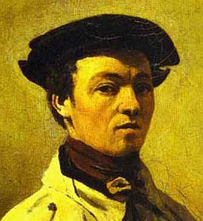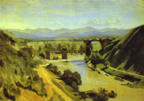Jean-Baptiste-Camille Corot Biography

Jean-Baptiste-Camille Corot was born on July 16, 1796 into the family of a draper. His mother was a fashionable milliner of the First Empire and Restoration periods. At the age of 19, Corot started attending evening classes at the atelier Suisse run by one of David's former pupils. He also had a studio built in the country house of his father at Ville-d' Avray, near Versailles.
In 1822 with the permission and financial aid from his parents Corot devoted himself entirely to painting. He joined the studio of the neoclassical landscapist Achille-Etna Michallon; then he took lessons from Jean-Victor Bertin. Already at that period Corot traveled tirelessly in the region around Paris and on the Channel coast and preferred to paint out of doors. "… he was born a traveler who was always on the move. He already had a wandering soul…"
Corot's first trip to Rome from 1825 to 1828 would become decisive to his development. He painted a number of oil studies from nature, views of historical Roman monuments and the scenery around Rome, pictures of women in their regional costume Rome: The Church of Trinità dei Monti Seen from the Valley of Trinità dei Monti, The Colosseum Seen through the Arcades of the Basilica of Constantine. Corot painted the Roman Campagna (Civita Castellana, Tivoli) and visited the Farnese Gardens and the Villa d'Este. He exhibited The Bridge at Narni, one of his pictures of the period, at the 1827 Salon.
On his return to France he continued to travel throughout the country and work out of doors. He painted landscapes of Normandy and Brittany, visited Chartres, Dunkirk and Saint-Omer in the north of France, traveled in Burgundy and the Auvergne. He often stayed in the forest of Fontainebleau, which inspired numerous woodland scenes.
At the same time he produced large historical compositions, such as Hagar in the Wilderness (Metropolitan Museum, New York), followed by Democritus (Musée des Beaux-Arts, Nantes), the Baptism of Christ(Church of Saint-Nicolas-du-Chardonnet, Paris), the Destruction of Sodom (Metropolitan Museum, New York), but it was his landscapes that brought him fame and are best remembered.
He made two further trips to Italy (in 1834 and 1843), went to Belgium and Holland (1854), traveled to England (1862), and visited Switzerland several times.
Corot was in his late thirties when he won his first medal at the Salon of 1933. In 1847 he was awarded the medal of the Légion d'Honneur. His growing popularity helped draw attention to naturalism. In 1870 Corot was elected a member of the Salon jury. During the Franco-Prussian War he donated big sum of money for his country defense.
During the Commune, Corot left Paris and stayed first in Arras, then went to Douai to see his friend Alfred Robaut, who started working on a biography of the painter. Corot had many friends and was generous in his friendship, both intellectually and financially. Thus the painter purchased a house for his friend Daumier, when the latter went bankrupt, and sent a sum of money to Millet's family after the painter's death.
In romantically lyrical landscapes, or paysages intimes, he began to capture the fleeting moods of nature in delicate nuances. White, added liberally to all his colors, gives the pictures a silvery look. His landscapes had an inspiring influence on the Impressionists and built his reputation in the eyes of the general public.
On February 22, 1875 Corot died in Ville-d'Array, at the age of 79.
Bibliography
Painting of Europe. XIII-XX centuries. Encyclopedic Dictionary. Moscow. Iskusstvo. 1999.
Camille Corot. By V. Alpatov. Moscow. 1984.
Corot in Italy: Open-Air Painting and the Classical Landscape Tradition by Peter Galassi, Jean-Baptiste-C Corot. Yale Univ Pr, 1991.
In the Light of Italy: Corot and Early Open-Air Painting by Philip Conisbee, Sarah Faunce (Contributor), Jeremy Strick (Contributor), National Gallery of ArtU.S., Brooklyn Museum, Peter Galassi. Natl Gallery of Art, 1996.
- Rome: The Church Of Trinità Dei Monti Seen From The Valley Of Trinità...

1826-28. Oil on paper mounted on canvas. 27.3 x 44.7 cm. Musée d'Art and d'Historie, Geneva, Switzerland.
- The Colosseum Seen Through The Arcades Of The Basilica Of Constantine.

1825. Oil on canvas. 23 x 35 cm. Louvre, Paris, France.
- The Bridge At Narni.

1826. A study. Oil on paper mounted on canvas 34 x 48 cm. A study done in 1826 for a painting exhibited in the Salon of 1827 (which is now in the National Gallery of Canada, Ottawa). Louvre, Paris, France.
- The Baptism Of Christ.

1844-45. Oil on canvas. 385 x205 cm. Church of Saint-Nicolas-du-Chardonnet, Paris, France. Read Note.